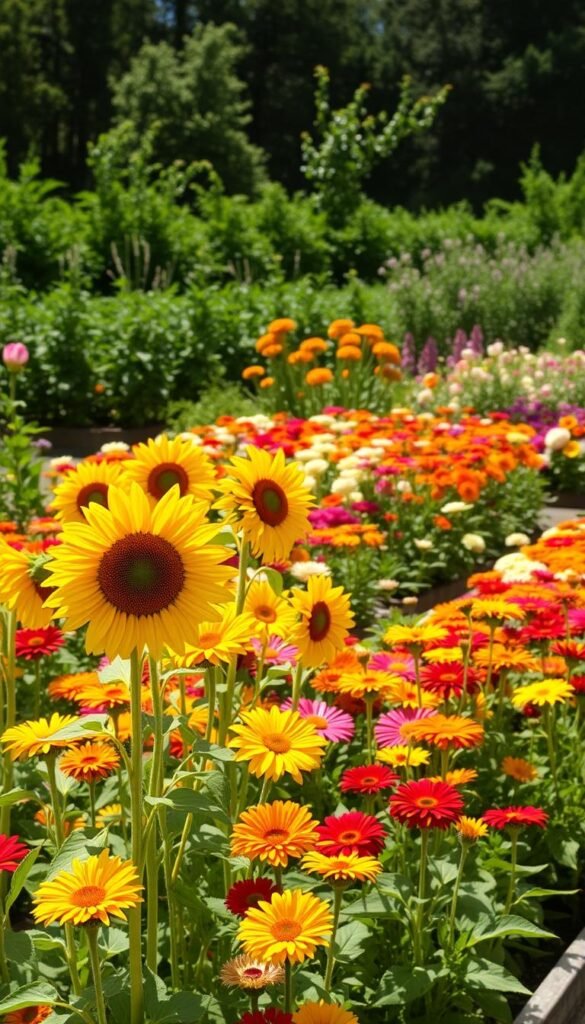Imagine stepping outside with a basket and shears to gather fresh stems whenever you need them. Designing a dedicated growing space for vibrant, harvest-ready plants lets you create stunning arrangements while enjoying nature’s beauty. Raised bed systems transform this vision into reality by giving you precise soil management and improved drainage—key factors for healthy, productive plants.
This approach simplifies maintenance compared to traditional methods. You’ll spend less time battling weeds and more time selecting stems for your next centerpiece. Strategic planning ensures a rotating display of colors and textures, keeping your vases filled from spring’s first buds to autumn’s final flourish.
Our guide walks you through every step—from choosing the ideal location to arranging plants for maximum visual impact. Discover how to extend your growing season and troubleshoot common challenges. Whether you’re new to gardening or refining existing skills, you’ll find actionable tips tailored to your needs.
Picture yourself surrounded by fragrant petals and lush foliage, knowing each stem represents your care and creativity. Let’s build a space that thrives while bringing beauty indoors all year.
Introduction to Planning Your Cut Flower Garden

A well-organized plan turns your floral dreams into year-round reality. Unlike decorative beds meant for curb appeal, spaces designed for harvesting prioritize durable stems and repeat blooms. Start by testing your soil—this simple step reveals what nutrients your plants need to thrive.
Your local climate plays a starring role in this process. Check your USDA growing zone to choose varieties that flourish in your area’s temperature ranges and frost dates. For example, zinnias love heat, while snapdragons prefer cooler springs.
Think like a conductor arranging an orchestra. Stagger planting dates so new buds open as older ones fade. This “succession planting” technique keeps your shears busy from early summer through fall. Mix quick-growing annuals like cosmos with reliable perennials such as lavender for nonstop color.
First-timers should start small—maybe two or three raised beds. Track what works in a notebook: bloom durations, pest issues, and favorite varieties. These notes become gold when expanding next year. Remember, even expert growers adjust their strategies season to season!
Understanding the Benefits of Raised Beds for Cut Flower Gardens

Elevated planting spaces transform how you cultivate blossoms for arrangements. Unlike traditional methods, these structures let you tailor conditions to your plants’ exact needs. Let’s explore why this approach helps you grow healthier stems while saving time and energy.
Why Elevated Planting Works Better
Improved drainage keeps roots from drowning during heavy rains—a common issue with delicate blossoms. The soil in raised areas warms faster in spring, letting you plant weeks earlier than in ground-level plots. You’ll notice fewer weeds thanks to contained spaces and defined pathways.
Working at waist height reduces strain on your back and knees. A simple hardware cloth layer under the soil blocks burrowing pests naturally. Custom soil mixes let you create ideal growing conditions for fussy varieties like dahlias or ranunculus.
| Feature | Raised Beds | In-Ground |
|---|---|---|
| Soil Warm-up Time | 2-3 weeks faster | Standard pace |
| Drainage | Excellent | Variable |
| Accessibility | Waist-high options | Ground level |
| Pest Control | Barrier options | Limited |
Maximizing Your Harvest Window
The contained environment acts like a solar panel, absorbing warmth to protect early and late crops. Frost-sensitive plants gain extra protection from cold ground temperatures. Extend your season further by adding hoops for row covers when temperatures dip unexpectedly.
Rotate crops efficiently between beds to maintain soil health year after year. Well-designed layouts let you add new sections seamlessly as your skills grow. This adaptability makes it easier to experiment with new varieties while keeping favorite staples in rotation.
Site Selection and Layout Strategies for Your Garden
Sunlight and soil aren’t just details—they’re the foundation of thriving plants. Start by walking your yard at different times to spot patterns. Morning shadows from buildings or trees might create microclimates that affect growth.
Evaluating Sunlight and Soil Conditions
Most flowering varieties demand at least six hours of direct sun daily. Use a free app or simple sun chart to track exposure across seasons. Areas near deciduous trees work well—they offer spring light before leafing out.
Test drainage by digging a 12-inch hole and filling it with water. If it takes over four hours to drain, consider raised mounds or mixing in gravel. Compacted earth benefits from organic matter like compost or aged manure.
Sloped spaces? Build terraced beds to prevent erosion. For stubborn clay soils, layer sand and compost to improve texture. Always leave 18-inch pathways between planting zones for easy access with tools and harvest baskets.
Sketch your space on grid paper, noting sun zones and water sources. This visual plan helps position tall specimens where they won’t shade shorter neighbors. Leave room for future expansions—maybe a dedicated section for fall-blooming stars next year!
Designing Your Garden Layout for Bouquet-Ready Blooms

Creating a space that dazzles both outdoors and in your vases starts with smart design choices. Think of your planting area as a living canvas where every stem serves dual purposes—beauty on-site and versatility in arrangements. Begin by sketching zones based on plant heights, grouping taller varieties like delphiniums at the back and shorter options like sweet peas up front.
Arranging Plants for Optimal Visual Appeal
Layer textures and shapes to add depth. Pair spiky snapdragons with round zinnia blooms, or soft lamb’s ear beside structured celosia. This textural contrast makes both your beds and bouquets pop. Leave 12-18 inches between plants to prevent overcrowding while allowing easy access for trimming.
Incorporate foliage plants like sage or ferns as natural backdrops. Their greenery highlights colorful petals and fills gaps between bloom cycles. Place fragrant herbs like mint or lemon balm along pathways—their scent enhances the experience while deterring pests.
Balancing Colors and Bloom Times
Choose a palette that transitions smoothly across seasons. Soft pinks and purples in spring can shift to fiery oranges by fall. Use a cut flower garden design guide to mix early risers like peonies with late stars like chrysanthemums.
Stagger planting dates every 2-3 weeks for continuous supply. Pair quick growers like marigolds with slower varieties like roses. Track each plant’s peak period to ensure something’s always ready to cut. This rhythm keeps your space lively and your vases full.
Implementing “Cut Flower Garden Layout Raised Beds: Grow Blooms for Bouquets All Season”

The blueprint is set; the next step is bringing your floral haven to life. Begin by assembling raised bed kits on level ground, securing corners with galvanized screws. Hardware cloth stapled to the bottom prevents voles and gophers from feasting on roots—a simple fix that saves future headaches.
Mix soil like a master chef crafting a signature dish. Combine 60% topsoil with 30% compost and 10% coarse sand for drainage. Fill beds within 2 inches of the rim to leave space for mulch. Test the texture—it should crumble like chocolate cake when squeezed.
Time your build using local frost dates as a guide. In cooler zones, start 4-6 weeks before last spring freeze. Warmer regions? Aim for fall installations to leverage milder temperatures. Use painter’s tape to mark plant positions on bed edges before digging—this visual guide ensures proper spacing.
Break tasks into weekend-friendly chunks:
- Week 1: Assemble structures and install barriers
- Week 2: Fill with soil mix and test drainage
- Week 3: Transplant seedlings or sow seeds
Snap progress photos and jot notes in a weatherproof journal. Record bloom dates, pest issues, and which stems last longest in vases. These insights become your personalized playbook for next year’s encore performance.
Choosing the Perfect Cut Flower Varieties

Selecting the right mix of plants transforms your space into a never-ending source of fresh stems. Focus on diverse textures and staggered bloom times to maintain vibrant displays. Start with reliable performers like zinnias and sunflowers—their sturdy stems and long vase life make them beginner favorites.
Annuals vs Perennials: Strategic Pairing
Annuals like cosmos and snapdragons deliver quick results, often blooming within 8 weeks from seeds. Perennials such as lavender and echinacea establish deeper roots, returning yearly with minimal effort. Blend both types to balance instant gratification with lasting structure.
| Feature | Annuals | Perennials |
|---|---|---|
| Bloom Duration | Single season | 3+ years |
| Maintenance | Replant yearly | Prune annually |
| Cost Efficiency | Low initial cost | Higher long-term value |
| Examples | Strawflowers, Sweet Peas | Peonies, Yarrow |
Order seeds from trusted suppliers like Johnny’s Selected Seeds for guaranteed germination rates. Prioritize varieties labeled “cut-and-come-again”—these produce new stems after harvesting. Check seed packets for indoor start dates versus direct-sow options based on your frost schedule.
Consider stem strength when choosing plants. Delicate poppies wilt quickly, while celosia maintains its shape for weeks. Track which varieties thrive in your climate using USDA zone maps. This prevents wasted effort on plants unsuited to your region’s weather patterns.
Planning for Continuous Blooms and Seasonal Interest
Keep your vases full by mastering nature’s rhythm. Succession planting lets you orchestrate a symphony of color that shifts gracefully from spring’s first crocus to autumn’s last aster. Instead of a single burst of beauty, you’ll create waves of fresh petals ready for clipping.
Using Succession Planting Techniques
Start by dividing your calendar into three acts: cool-weather stars like pansies kick things off in early spring. As temperatures rise, replace them with heat-loving zinnias or cosmos. When fall whispers its arrival, tuck in chrysanthemums or ornamental kale.
Try this simple schedule:
- March-April: Sow hardy annuals (sweet peas, larkspur)
- May-June: Plant summer showstoppers (dahlias, sunflowers)
- August-September: Seed fall performers (asters, marigolds)
Pinch back early buds on fast growers like snapdragons. This delays their peak bloom time, stretching your harvest window. Deadhead spent flowers weekly to redirect energy into new buds rather than seed production.
Mix plants with different maturation rates in the same bed. Pair quick-sprouting nasturtiums (14 days) with slower foxgloves (21 days). You’ll enjoy overlapping displays instead of empty gaps. Track each variety’s progress using a wall calendar or gardening app.
Rotate crops between beds each year to prevent soil fatigue. Follow heavy feeders like roses with nitrogen-fixing sweet peas. This dance keeps your earth healthy while maintaining visual interest through the seasons.
Practical Tips for Planting and Maintaining Your Garden
Success in your green haven hinges on mastering essential care routines. Start by spacing seedlings 6-8 inches apart with 12-15 inches between rows—this gives roots room to expand while allowing air circulation. Proper spacing reduces disease risks and makes harvesting easier later.
Mix compost into your soil before planting to boost nutrient levels. For seeds, follow packet instructions for depth—most need coverage 2-3 times their width. Water gently after sowing to avoid displacing tiny particles.
| Task | Frequency | Best Time |
|---|---|---|
| Watering | 2-3x weekly | Early morning |
| Fertilizing | Every 4 weeks | After rainfall |
| Deadheading | Weekly | Cool evenings |
Spread 2 inches of mulch around stems to lock in moisture and block weeds. Check plants daily for pests—handpick beetles or spray neem oil at first signs of trouble. Trim spent blooms regularly to encourage new buds.
Adjust routines with the seasons. In spring, test soil pH and add lime if needed. Summer demands vigilant watering—use drip lines for efficiency. Fall cleanup prevents diseases from overwintering in fallen leaves.
Harvest stems when buds show color but haven’t fully opened. Use sharp shears angled at 45 degrees. Place flowers in lukewarm water immediately to maximize vase life. Rotate cutting locations to keep displays fresh and balanced.
Leveraging Affiliate Links and Trusted Sources for Garden Supplies
Smart sourcing transforms your planting efforts from guesswork to guaranteed success. Partnering with reputable suppliers ensures you get viable seeds and durable tools while supporting creators through affiliate links. These collaborations let bloggers earn commissions while directing you to proven products.
Trusted sources like Johnny’s Selected Seeds and Burpee offer germination-tested varieties perfect for your beds. Look for companies providing:
- Detailed growing guides specific to your USDA zone
- Customer reviews with real photos
- Guaranteed replacement policies for dud seeds
Evaluate recommendations by comparing prices across multiple affiliate links. A $5 trowel might seem tempting, but investing in stainless steel tools saves replacement costs. Seasonal sales at Eden Brothers or Select Seeds often slash prices on bulk seeds—stock up during winter for spring planting.
Build relationships with local nurseries and online retailers offering loyalty programs. Many provide early access to new varieties or exclusive discounts. Sign up for newsletters from Baker Creek Heirloom Seeds or Territorial Seed Company for timely growing tips.
Prioritize quality over quantity when acquiring supplies. Durable pruners from Fiskars or ergonomic kneepads from Radius Garden make maintenance easier season after season. Check gardening blogs for curated sources—their affiliate partnerships often reflect hands-on testing rather than paid promotions.
Creating a Sustainable, Pollinator-Friendly Cut Flower Garden
Your floral oasis can buzz with life while yielding beautiful stems for arrangements. By welcoming bees, butterflies, and beneficial insects, you create a thriving ecosystem that boosts plant health and productivity. Start by choosing beginner-friendly blooms like cosmos and zinnias—their open faces make nectar accessible to winged visitors.
Nature-Driven Design Strategies
Native plants like purple coneflower and milkweed adapt effortlessly to local conditions, requiring less water and care. Mix them with non-invasive favorites like lavender to extend your harvest window. Single-petal varieties work double duty—they’re easier for pollinators to navigate and often last longer in vases.
Try these earth-friendly techniques:
- Install shallow water dishes with pebbles for thirsty bees
- Leave spent sunflower heads as winter bird feeders
- Plant marigolds near veggies to deter pests naturally
Ditch chemical sprays in favor of companion planting. Nasturtiums lure aphids away from prized stems, while dill attracts predatory wasps that control caterpillars. A variety of heights and bloom times ensures constant activity—tall sunflowers shelter ground-level clover that fixes nitrogen in soil.
Maintain your eco-haven with organic mulch and hand-weeding. Track which flowers draw the most pollinators using a simple journal. You’ll soon spot patterns that help refine plant selections for both beauty and ecological impact.
Troubleshooting Common Garden Challenges
Every thriving space has its share of surprises, but quick solutions keep your plants flourishing. Spotting tiny holes in leaves? You might be hosting earwigs or slugs. A shallow dish of beer sunk into the soil near affected areas traps these nighttime nibblers effectively.
Woodchucks eyeing your flowers? Bury chicken wire 12 inches deep around bed edges—their sensitive paws hate the texture. For persistent voles, plant garlic or daffodils as natural repellents. These bulbs release odors underground that burrowing pests avoid.
Soggy soil causing yellow leaves? Mix in perlite or coarse sand to improve drainage. Space plants according to their mature size—overcrowding invites fungal diseases. Rotate crops yearly to prevent nutrient depletion and disrupt pest life cycles.
Struggling with weeds? Apply corn gluten meal in early spring—it stops seeds from sprouting without chemicals. Choose disease-resistant variety types like zinnias or marigolds for worry-free color. Regular checks let you catch issues early, ensuring your garden stays vibrant and productive.






